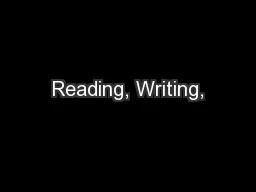PPT-Reading, Writing,
Author : debby-jeon | Published Date : 2017-07-29
Speaking and Listening in the Arts Close Reading in Musical Theatre Workshop Goals Understand the increased text complexity demands of the CCSS and the value
Presentation Embed Code
Download Presentation
Download Presentation The PPT/PDF document "Reading, Writing," is the property of its rightful owner. Permission is granted to download and print the materials on this website for personal, non-commercial use only, and to display it on your personal computer provided you do not modify the materials and that you retain all copyright notices contained in the materials. By downloading content from our website, you accept the terms of this agreement.
Reading, Writing,: Transcript
Download Rules Of Document
"Reading, Writing,"The content belongs to its owner. You may download and print it for personal use, without modification, and keep all copyright notices. By downloading, you agree to these terms.
Related Documents


![[EBOOK] - 5 Kinds of Nonfiction: Enriching Reading and Writing Instruction with Children\'s](https://thumbs.docslides.com/901384/ebook-5-kinds-of-nonfiction-enriching-reading-and-writing-instruction-with-children-s-books.jpg)
![[EPUB] - 180 Days of Writing for Second Grade - An Easy-to-Use Second Grade Writing Workbook](https://thumbs.docslides.com/901424/epub-180-days-of-writing-for-second-grade-an-easy-to-use-second-grade-writing-workbook-to-practice-and-improve-writing-skills.jpg)
![[DOWNLOAD] - 180 Days of Writing for Third Grade - An Easy-to-Use Third Grade Writing](https://thumbs.docslides.com/901429/download-180-days-of-writing-for-third-grade-an-easy-to-use-third-grade-writing-workbook-to-practice-and-improve-writing-skills.jpg)
![[READ] - 180 Days of Reading: Grade 6 - Daily Reading Workbook for Classroom and Home,](https://thumbs.docslides.com/901547/read-180-days-of-reading-grade-6-daily-reading-workbook-for-classroom-and-home-reading-comprehension-and-phonics-practice.jpg)
![[EBOOK] - Teaching Writing in Kindergarten: A Structured Approach to Daily Writing That](https://thumbs.docslides.com/901683/ebook-teaching-writing-in-kindergarten-a-structured-approach-to-daily-writing-that-helps-every-child-become-a-confident-capabl.jpg)
![[READ] - Writing a Successful College Application Essay (Barron\'s Writing a Successful](https://thumbs.docslides.com/901982/read-writing-a-successful-college-application-essay-barron-s-writing-a-successful-college-application-essay.jpg)
![[EPUB] - Praxis Core Study Guide 2021-2022: Praxis Core Academic Skills for Educators](https://thumbs.docslides.com/902058/epub-praxis-core-study-guide-2021-2022-praxis-core-academic-skills-for-educators-test-prep-book-with-reading-writing-and-mat.jpg)
![[DOWNLOAD] - SAT Reading & Writing Packets (2020 Edition): Practice Materials and Study](https://thumbs.docslides.com/902313/download-sat-reading-writing-packets-2020-edition-practice-materials-and-study-guide-for-the-sat-evidence-based-reading-and-wr.jpg)
![[EPUB] - Businesspeople Don\'t Like to Read, We Scan: A Quick, Strategic Guide for Effective](https://thumbs.docslides.com/902899/epub-businesspeople-don-t-like-to-read-we-scan-a-quick-strategic-guide-for-effective-business-writing-speaking-and-writing.jpg)
![[READ] - The Only Writing Series You\'ll Ever Need - Grant Writing: A Complete Resource](https://thumbs.docslides.com/905612/read-the-only-writing-series-you-ll-ever-need-grant-writing-a-complete-resource-for-proposal-writers.jpg)
![[EBOOK] - Praxis Core Study Guide 2021-2022: Praxis Core Academic Skills for Educators](https://thumbs.docslides.com/905732/ebook-praxis-core-study-guide-2021-2022-praxis-core-academic-skills-for-educators-test-prep-book-with-reading-writing-and-mat.jpg)
![[EBOOK] - Common Core Achieve, GED Exercise Book Reading And Writing (BASICS & ACHIEVE)](https://thumbs.docslides.com/905738/ebook-common-core-achieve-ged-exercise-book-reading-and-writing-basics-achieve.jpg)
![[EPUB] - Writing a Successful College Application Essay (Barron\'s Writing a Successful](https://thumbs.docslides.com/906666/epub-writing-a-successful-college-application-essay-barron-s-writing-a-successful-college-application-essay.jpg)